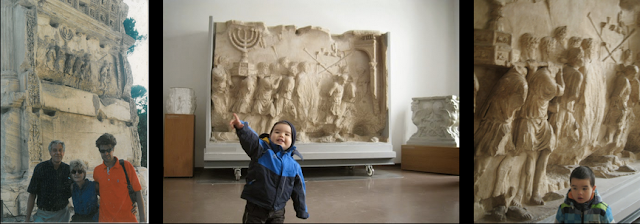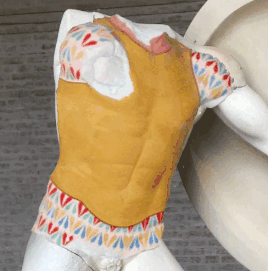Will eventually get this page sorted...
The Glyptothek













 |
| As it appeared after being transferred to the Zentralministerium's Luftschutzkeller on Ludwigstrasse |
"[T]he mere knowledge that such a work could be created and still exists in the world makes me feel twice the person I was ... If I can get hold of a good cast of this Medusa, I shall bring it back with me..."Goethe, Italian Journey
 The
Äginetensaal then and now, housing the marbles from the Late Archaic
temple of Aphaia, comprising the sculptural groups of the east and west
pediments. After the building's destruction during the air raids on
Munich in the Second World War reconstruction was finally begun in 1947
with the reopening taking place in 1972. The frescoes executed by Peter
Cornelius between 1820 and 1830 such as Die Götter Griechenlands had
been destroyed and were not restored, but rather isolated fragments
were preserved and are held in the National Gallery in Berlin. The
Assyrian Hall built by Klenze in the courtyard in 1864 was not restored
after the war; the eight Assyrian Orthostat reliefs from the palace of king Ashur-nasir-pal II and
the Babylonian lion from the Ishtar Gate were moved into the Staatliche
Sammlung für Ägyptische Kunst. The large column in the inner courtyard
is from the former vestibule of the opposite building, which had sadly
been reconstructed in the careless modern fashion.
The
Äginetensaal then and now, housing the marbles from the Late Archaic
temple of Aphaia, comprising the sculptural groups of the east and west
pediments. After the building's destruction during the air raids on
Munich in the Second World War reconstruction was finally begun in 1947
with the reopening taking place in 1972. The frescoes executed by Peter
Cornelius between 1820 and 1830 such as Die Götter Griechenlands had
been destroyed and were not restored, but rather isolated fragments
were preserved and are held in the National Gallery in Berlin. The
Assyrian Hall built by Klenze in the courtyard in 1864 was not restored
after the war; the eight Assyrian Orthostat reliefs from the palace of king Ashur-nasir-pal II and
the Babylonian lion from the Ishtar Gate were moved into the Staatliche
Sammlung für Ägyptische Kunst. The large column in the inner courtyard
is from the former vestibule of the opposite building, which had sadly
been reconstructed in the careless modern fashion.The Trojanischer Saal as it appeared before the war and today. Hitler and his followers were fascinated with antiquity (hence the classical style of Troost's party buildings). The Königsplatz was called Acropolis Germaniae (in a startling reminder of Ludwig's Athens on the Isar), and Hitler claimed, "Never has mankind been nearer to antiquity in appearance and sensibility than today." This last point was made visually in Hans W. Fischer's 1935 book Menschenschönheit, which juxtaposed works of art with photographs of contemporary people, mainly athletes. In one two-page spread, a warrior from the east pediment at Aegina was juxtaposed with a modern javelin thrower.
 The Äginetensaal then and now, housing the marbles from the Late Archaic temple of Aphaia, comprising the sculptural groups of the east and west pediments. Restored by the Danish neoclassic sculptor Bertel Thorvaldsen, they exerted a formative influence on the local character of Neoclassicism in Munich, as exhibited in the architecture of Leo von Klenze. Each pediment centred on the figure of Athena, with groups of combatants, fallen warriors, and arms filling the decreasing angles of the pediments. The theme shared by the pediments was the greatness of Aigina as shown by the exploits of its local heroes in the two Trojan wars, one lead by Heracles against Laomedon and a second lead by Agamemnon against Priam. According to the standard myths, Zeus raped the nymph Aigina, who bore the first king of the island, Aiakos. This king had the sons Telamon (father of the Homeric hero Ajax) and Peleus (father of the Homeric hero Achilles). The sculptures preserve extensive traces of a complex paint scheme, and are crucial for the study of painting on ancient sculpture. The marbles are finished even on the back surfaces of the figures, despite the fact that these faced the pediment and were thus not visible.
The Äginetensaal then and now, housing the marbles from the Late Archaic temple of Aphaia, comprising the sculptural groups of the east and west pediments. Restored by the Danish neoclassic sculptor Bertel Thorvaldsen, they exerted a formative influence on the local character of Neoclassicism in Munich, as exhibited in the architecture of Leo von Klenze. Each pediment centred on the figure of Athena, with groups of combatants, fallen warriors, and arms filling the decreasing angles of the pediments. The theme shared by the pediments was the greatness of Aigina as shown by the exploits of its local heroes in the two Trojan wars, one lead by Heracles against Laomedon and a second lead by Agamemnon against Priam. According to the standard myths, Zeus raped the nymph Aigina, who bore the first king of the island, Aiakos. This king had the sons Telamon (father of the Homeric hero Ajax) and Peleus (father of the Homeric hero Achilles). The sculptures preserve extensive traces of a complex paint scheme, and are crucial for the study of painting on ancient sculpture. The marbles are finished even on the back surfaces of the figures, despite the fact that these faced the pediment and were thus not visible.




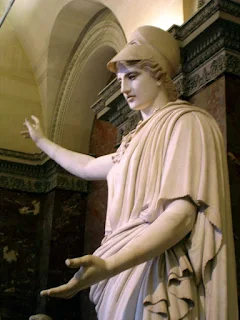




1945 and today

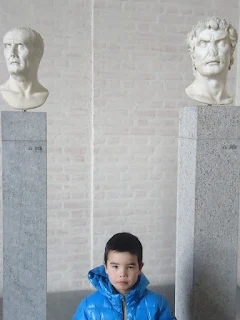







 Beside copies of the Drunken Old Woman in Munich (above) and in Rome (below). Created in the Hellenistic period, the exact time of its creation cannot be determined but is generally dated to the late third century BCE. The bulky, blocky composition and the pyramidal structure is comparable to the Scythians of the Marsyas Flayer Group, which is dated to the first half of the second century BCE and to the figure of the Goose strangler, which is dated to the middle or later third century BCE, both of which share the same space. The copy in Munich is dated to the first century CE and is considered the better copy whilst that in the Capitoline is dated to the second century CE. According to Pliny the original version of the statue was displayed at Smyrna in Asia Minor. In book 36 of his Natural History, he lists 32 significant marble artworks which were not located in Rome, including an anus ebria (Drunken crone") said to have been made by Myron of Thebes which he incorrectly equates with the homonymous sculptor Myron who lived in the fifth century BCE. Alexandria has been suggested as a second possible location of the original on account of the lagynos which the old woman holds in front of herself. The lagynos was the source of the name of the lagynophoria, the flask-festival, which was founded by Ptolemy IV. The statue of the Old Drunkard in the Munich Glyptothek was in the possession of Cardinal Ottoboni in Rome from 1700 and at the time was among the best known antiquities in the city. Leo von Klenze refused to admit the Old Drunkard into the Glyptothek when it was established by King Ludwig I. In 1895 the statue was finally put on display in the Munich Glyptothek by Adolf Furtwängler, in the "Roman gallery" rather than with the Greek sculpture. Today the sculpture is counted among the show-pieces of the collection, along with the Barberini Faun and the Boy with the Goose.
Beside copies of the Drunken Old Woman in Munich (above) and in Rome (below). Created in the Hellenistic period, the exact time of its creation cannot be determined but is generally dated to the late third century BCE. The bulky, blocky composition and the pyramidal structure is comparable to the Scythians of the Marsyas Flayer Group, which is dated to the first half of the second century BCE and to the figure of the Goose strangler, which is dated to the middle or later third century BCE, both of which share the same space. The copy in Munich is dated to the first century CE and is considered the better copy whilst that in the Capitoline is dated to the second century CE. According to Pliny the original version of the statue was displayed at Smyrna in Asia Minor. In book 36 of his Natural History, he lists 32 significant marble artworks which were not located in Rome, including an anus ebria (Drunken crone") said to have been made by Myron of Thebes which he incorrectly equates with the homonymous sculptor Myron who lived in the fifth century BCE. Alexandria has been suggested as a second possible location of the original on account of the lagynos which the old woman holds in front of herself. The lagynos was the source of the name of the lagynophoria, the flask-festival, which was founded by Ptolemy IV. The statue of the Old Drunkard in the Munich Glyptothek was in the possession of Cardinal Ottoboni in Rome from 1700 and at the time was among the best known antiquities in the city. Leo von Klenze refused to admit the Old Drunkard into the Glyptothek when it was established by King Ludwig I. In 1895 the statue was finally put on display in the Munich Glyptothek by Adolf Furtwängler, in the "Roman gallery" rather than with the Greek sculpture. Today the sculpture is counted among the show-pieces of the collection, along with the Barberini Faun and the Boy with the Goose. The sculpture depicts an aged woman, who squats on the ground and holds an open flask in her lap. At a height of around 92 centimetres, the statue is about life size. The woman sits on the ground and extends her legs in front of herself and crosses her ankles such that the left leg sits in front of the right one. She holds the lagynos flask in her lap, grasping it tightly around the neck and belly. The flask which presumably holds unmixed win, is decorated with an ivy vine pattern. The woman is dressed in a chiton which would be secured with metal pins and which is girded round the middle of the body with a belt. The right pin has slipped off her shoulder, leaving her upper body uncovered, without exposing her breast. The motif of the pin which has slipped off the shoulder traditionally had erotic connotations and appears especially in depictions of the goddess of love, Aphrodite. Over the chiton, the woman wore a heavy cloak, which has fallen to the ground and piles up around her. The woman's clothing recalls contemporary fashion. The same clothing is also found in depictions of Aphrodite and Nymphs, and also of distinguished women of the time. On the exposed upper body, the collar bone and ribs emerge from the Décolletage, as do the shoulder blades and the spinal column at the back. The skin is stretched in a thin sheet over the skeleton and the underlying muscles, veins and tendons are depicted in an anatomically correct way. A thick vein runs up her neck directly under the skin and disappears into a jowl under her chin. Pierced ears indicate golden earrings, which would have been inserted. A headscarf holds her hair out of her face. The head is raised, mouth is slightly open and her eyes stare off into space. Her skin is loose and hangs in folds over her cheeks and jaw. The Nasolabial fold is pronounced and crow's feet surround the eyes. The open mouth exposes two remaining teeth. The woman's hair is carefully styled, wrapped at the sides and gathered up with a band above the neck. Her headscarf is carefully wrapped around her head; a few locks peep out under it, as if by accident. She wears two rings on her left hand, one on her pointing finger and one on her ringfinger, which implies that she was wealthy and had some social status.
The sculpture depicts an aged woman, who squats on the ground and holds an open flask in her lap. At a height of around 92 centimetres, the statue is about life size. The woman sits on the ground and extends her legs in front of herself and crosses her ankles such that the left leg sits in front of the right one. She holds the lagynos flask in her lap, grasping it tightly around the neck and belly. The flask which presumably holds unmixed win, is decorated with an ivy vine pattern. The woman is dressed in a chiton which would be secured with metal pins and which is girded round the middle of the body with a belt. The right pin has slipped off her shoulder, leaving her upper body uncovered, without exposing her breast. The motif of the pin which has slipped off the shoulder traditionally had erotic connotations and appears especially in depictions of the goddess of love, Aphrodite. Over the chiton, the woman wore a heavy cloak, which has fallen to the ground and piles up around her. The woman's clothing recalls contemporary fashion. The same clothing is also found in depictions of Aphrodite and Nymphs, and also of distinguished women of the time. On the exposed upper body, the collar bone and ribs emerge from the Décolletage, as do the shoulder blades and the spinal column at the back. The skin is stretched in a thin sheet over the skeleton and the underlying muscles, veins and tendons are depicted in an anatomically correct way. A thick vein runs up her neck directly under the skin and disappears into a jowl under her chin. Pierced ears indicate golden earrings, which would have been inserted. A headscarf holds her hair out of her face. The head is raised, mouth is slightly open and her eyes stare off into space. Her skin is loose and hangs in folds over her cheeks and jaw. The Nasolabial fold is pronounced and crow's feet surround the eyes. The open mouth exposes two remaining teeth. The woman's hair is carefully styled, wrapped at the sides and gathered up with a band above the neck. Her headscarf is carefully wrapped around her head; a few locks peep out under it, as if by accident. She wears two rings on her left hand, one on her pointing finger and one on her ringfinger, which implies that she was wealthy and had some social status.
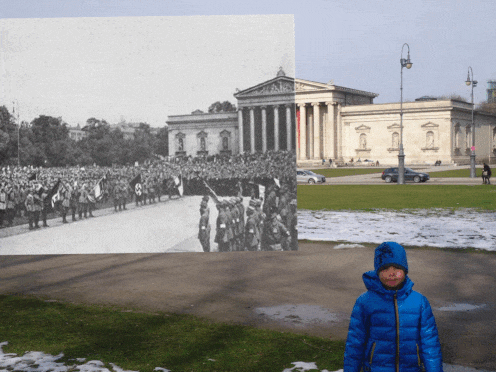
| During the annual commemorative marches past the Glyptothek and Antikensammlungen |
 The State Collections of Antiques in the Kunstareal of Munich is a museum for the Bavarian state's antique collections for Greek, Etruscan and Roman art. The Bavarian state collection of Ancient Egyptian art is traditionally placed in its own museum. The neo-classical building at Königsplatz with Corinthian columns was established in 1848 as counterpart to the opposite Glyptothek and commissioned by the Bavarian King Ludwig I; the swastikas around its entrance date from this time. The architect was Georg Friedrich Ziebland. Already from 1869 to 1872 the building housed the royal antiquarium before the Munich Secession resided here from 1898 to 1912. From 1919 the building contained the New State Gallery. The museum building was severely damaged by bombing in World War II when it especially lost its Etruscan pottery, which was stored in the bombed Neue Pinakothek. It was eventually reconstructed and reopened to the public in the late 1960s to display the State Collection of Antiques.
The State Collections of Antiques in the Kunstareal of Munich is a museum for the Bavarian state's antique collections for Greek, Etruscan and Roman art. The Bavarian state collection of Ancient Egyptian art is traditionally placed in its own museum. The neo-classical building at Königsplatz with Corinthian columns was established in 1848 as counterpart to the opposite Glyptothek and commissioned by the Bavarian King Ludwig I; the swastikas around its entrance date from this time. The architect was Georg Friedrich Ziebland. Already from 1869 to 1872 the building housed the royal antiquarium before the Munich Secession resided here from 1898 to 1912. From 1919 the building contained the New State Gallery. The museum building was severely damaged by bombing in World War II when it especially lost its Etruscan pottery, which was stored in the bombed Neue Pinakothek. It was eventually reconstructed and reopened to the public in the late 1960s to display the State Collection of Antiques. 








He is the great master of the white lekythos. His red-figure vases nearly always have a sober beauty, but few of them–like the pointed amphora in the Cabinet des Médailles–reach the height of his best white lekythoi, which are among the masterpieces of ancient drawing.




Linos was killed by Heracles during a musical lesson because he reprimanded his pupil for making mistakes. This painture shows the lesson room, four pupils and the young Heracles seized by anger against his teacher. The hero overwhelms his master and bits him with a leg of a destroyed chair. Linos tries to hold out the aggressor with his hand and his lyre provides just a weak and disparate resistance to Herakles’s impetuosity.Lehrer Tot- Schule Aus (Teacher Dead, School Out)



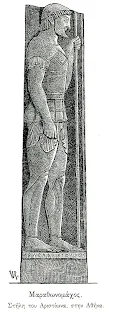




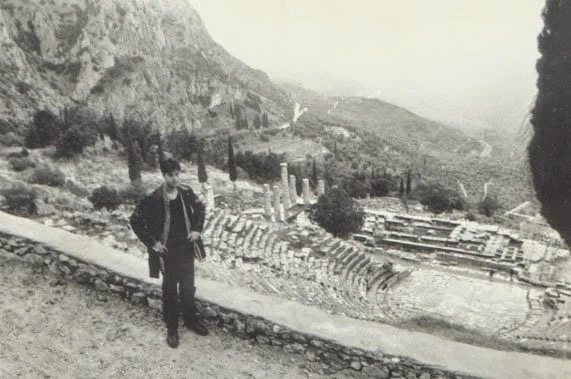


  |
| Even the lights and hand rails are unchanged |

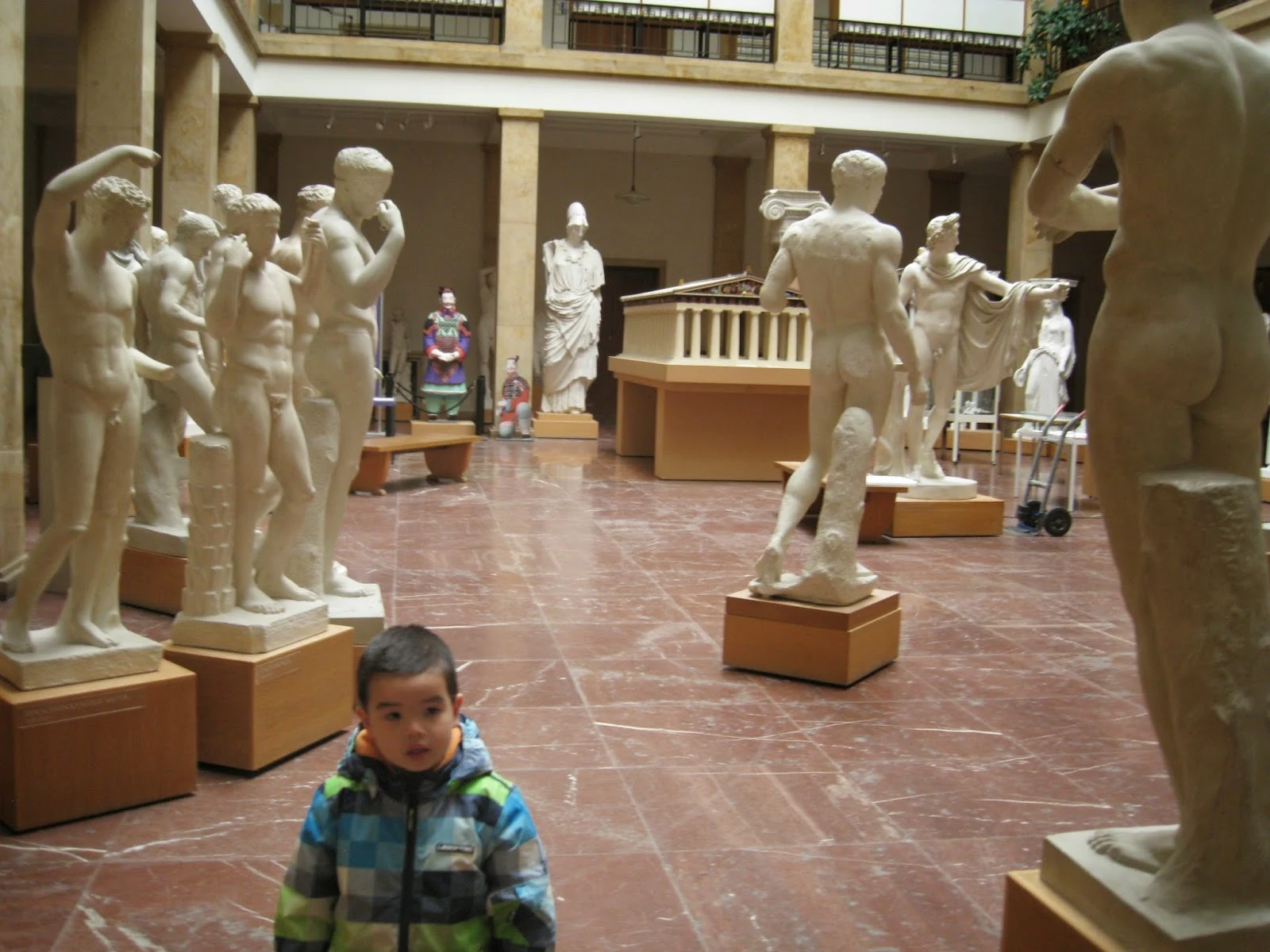





 Sixteenth-century drawing showing the group of Laocöon as it was found missing arms after it had been discovered on January 14, 1506. Giuliano da Sangallo and Michelangelo Buonarroti were amongst the first to see the statue and propose a hypothesis for the original form of the missing arms, noting from the remaining traces that the missing right arms of the father and of his son were raised and that the snake seemed to have been around the father’s right arm and its tail around the son’s arm. They also thought that the father might have had some weapon in his hand. The statue was soon brought to the collection of the Vatican Belvedere, and Bramante organized a competition inviting four artists to model it in wax. Raphael was amongst the judges and he considered that the young Sansovino had far surpassed the others. So, by the advice of Cardinal Domenico Grimani, Bramante dicided that Jacopo’s model should be cast in bronze. Sansovino was the first restorer of the statue integrating the missing parts - probably in gypsum. It seems that the arm of Laocoon was bent towards the head in this restoration. A few years later, Baccio Bandinelli, who had been commissioned to make a replica in marble, made a new repair for the arm of Laocoon, which had broken off in the meantime. He made the arm stretch upwards much more than had Sansovino. Bandinelli proudly claimed he had surpassed the antiques with his replica, but Michelangelo commented: “Who follows others, will never pass in front of them, and who is not able to do well himself, cannot make good use of the works of others.” In 1532, Michelangelo recommended one of his collaborators, Fra Giovanni Angiolo Montorsoli, to restore some broken statues in the Belvedre including the left arm of Apollo and the right arm of Laocoon. The work was accorded “the greatest affection” by the pope. Laocoon’s arm was made in terracotta and pointed straight; this gave strong diagonal movement to the statue, differing greatly from the original closed expression with a bent arm (as was later discovered).
Sixteenth-century drawing showing the group of Laocöon as it was found missing arms after it had been discovered on January 14, 1506. Giuliano da Sangallo and Michelangelo Buonarroti were amongst the first to see the statue and propose a hypothesis for the original form of the missing arms, noting from the remaining traces that the missing right arms of the father and of his son were raised and that the snake seemed to have been around the father’s right arm and its tail around the son’s arm. They also thought that the father might have had some weapon in his hand. The statue was soon brought to the collection of the Vatican Belvedere, and Bramante organized a competition inviting four artists to model it in wax. Raphael was amongst the judges and he considered that the young Sansovino had far surpassed the others. So, by the advice of Cardinal Domenico Grimani, Bramante dicided that Jacopo’s model should be cast in bronze. Sansovino was the first restorer of the statue integrating the missing parts - probably in gypsum. It seems that the arm of Laocoon was bent towards the head in this restoration. A few years later, Baccio Bandinelli, who had been commissioned to make a replica in marble, made a new repair for the arm of Laocoon, which had broken off in the meantime. He made the arm stretch upwards much more than had Sansovino. Bandinelli proudly claimed he had surpassed the antiques with his replica, but Michelangelo commented: “Who follows others, will never pass in front of them, and who is not able to do well himself, cannot make good use of the works of others.” In 1532, Michelangelo recommended one of his collaborators, Fra Giovanni Angiolo Montorsoli, to restore some broken statues in the Belvedre including the left arm of Apollo and the right arm of Laocoon. The work was accorded “the greatest affection” by the pope. Laocoon’s arm was made in terracotta and pointed straight; this gave strong diagonal movement to the statue, differing greatly from the original closed expression with a bent arm (as was later discovered).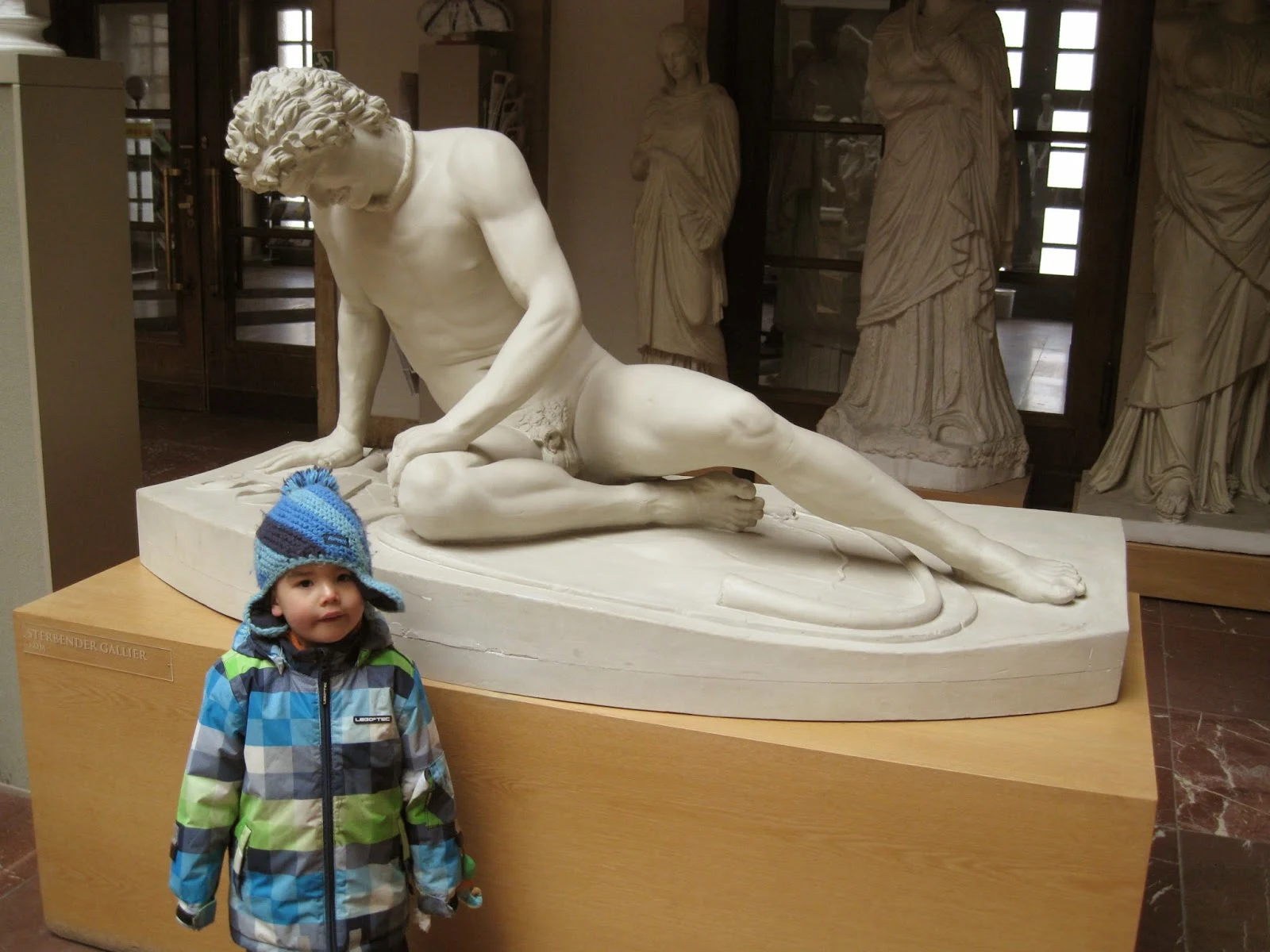

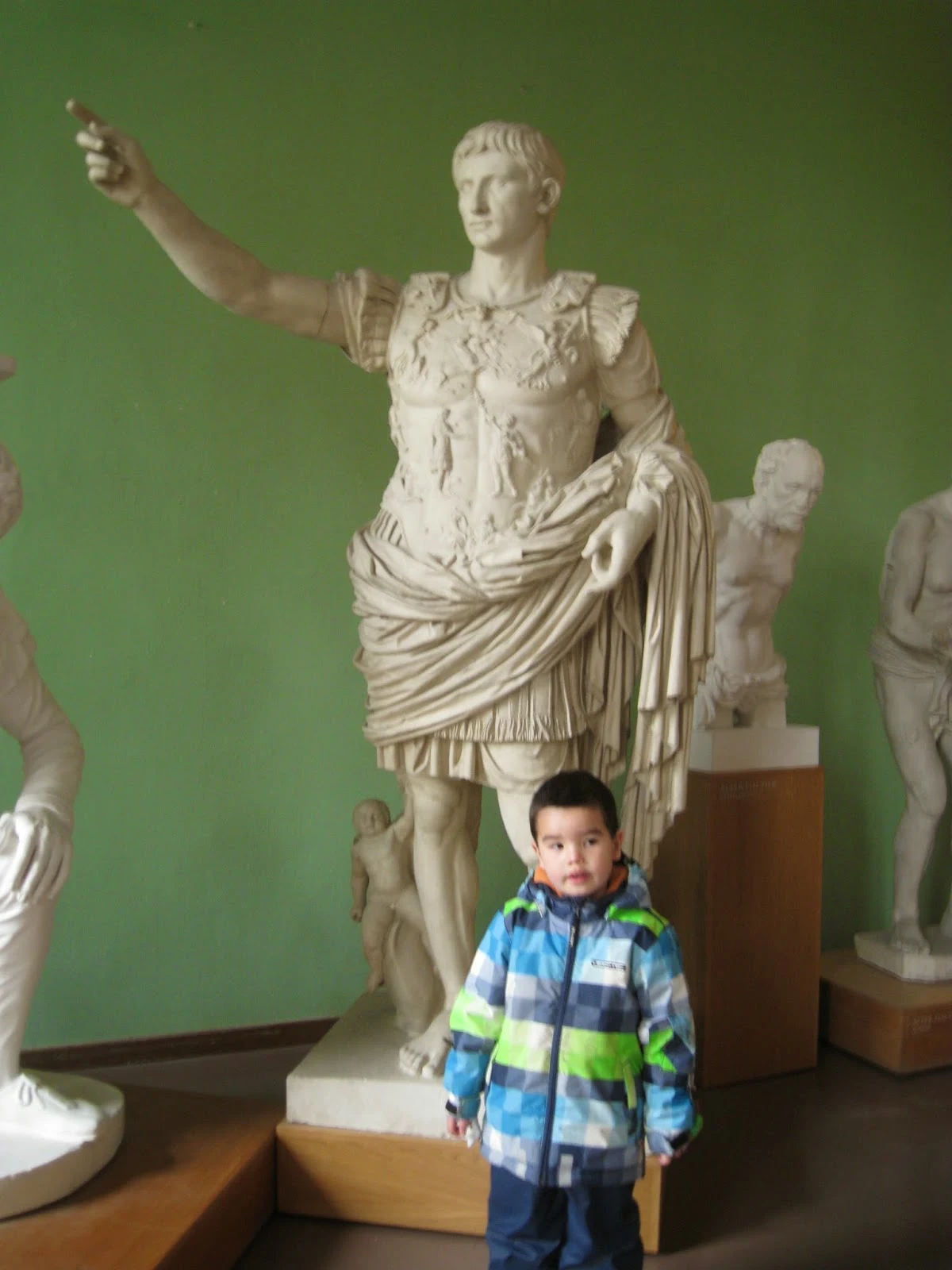








Herakles, in the course of his labours, is shown reacting to a variety of experiences and, as he does so, growing old. In the first of the labours depicted in the cycle, his battle with the Nemean lion, he had been shown as a beardless youth with a creased brow and downcast look designed to express the worry and exhaustion that followed his initial struggle. (The head can be seen in the archaeological museum in Olympia.) In the last metope of the cycle, exhibited here, by contrast, we see him at the end of his labours as a mature, calm, full-bearded figure who temporarily takes the world on his shoulders while the giant Atlas brings forward the apples of the Hesperides. The metope beautifully captures what the Greeks of the early classical period saw as important in their own experience. Herakles has been tested by adversity, has prevailed, has grown in understanding, and has in the end attained a kind of mature philosophical calm.
Buitron-Oliver (35-36)
This relief, a metope placed on the east end of the temple, represents the last of Herakles' labours: obtaining the golden apples of immortality. The hero stands in the centre holding up the heavens with the help of his patron goddess Athena. The giant Atlas, who normally supported the skies, had been persuaded to fetch the golden apples from a tree in the garden of the Hesperides, where they were guarded by a dragon, and now he has returned and is presenting them to Herakles. Only Atlas knew the location of the garden, which was popularly imagined to have been in the far west of the known world, beyond the Atlas mountains in North Africa, as the names Hesperides and Atlas suggest.
The composition draws attention to the apples by contrasting the three verticals of the figures with the horizontal of the outstretched arms of Atlas. The rigid verticals of Athena and Herakles emphasise the weight of the heavens, which is enhanced by the folded cushion Herakles uses to help distribute the load. The cushion also brings the figure of the hero level with the goddess and the giant.
Successful completion of the twelve labours was to bring immortality to the mortal hero Herakles as the symbolism here makes clear, for the golden apples were apples from the tree of life.






 The Apollon of Olympia, part of the group of sculptures found in the west pediment of the Temple of Zeus at Olympia currently in the archaeological museum in Olympia where Dad had his photo taken in front of the real thing. The sculptures of the west pediment depicted the battle of the Lapiths against the Centaurs, following the wedding feast of Peirithous and Hippodamia. The battle of the Lapiths - legendary inhabitants of Thessaly - against the Centaurs - wild forest inhabitants with a human upper half and the body of a horse - frequently acted as a mythological metaphor for the conflicts between the Greeks and the Barbarians. Most of the figures in this turbulent battle scene were discovered during the German excavations of 1875, led by the archaeologist Georg Treu. The juvenile Apollo stood in the centre of the pediment, directing his gaze toward the Lapiths. With his outstretched right arm, he seemed to order an end to the iniquity: the Centaurs had betrayed the Lapiths' hospitality, drunk to excess, and kidnapped their women. Nevertheless, his inclusion appears to be merely figurative; the combatants seem ignorant of his presence, with no other figure in the pediment referring, either in their motion or gesture, to the appearance of the god.
The Apollon of Olympia, part of the group of sculptures found in the west pediment of the Temple of Zeus at Olympia currently in the archaeological museum in Olympia where Dad had his photo taken in front of the real thing. The sculptures of the west pediment depicted the battle of the Lapiths against the Centaurs, following the wedding feast of Peirithous and Hippodamia. The battle of the Lapiths - legendary inhabitants of Thessaly - against the Centaurs - wild forest inhabitants with a human upper half and the body of a horse - frequently acted as a mythological metaphor for the conflicts between the Greeks and the Barbarians. Most of the figures in this turbulent battle scene were discovered during the German excavations of 1875, led by the archaeologist Georg Treu. The juvenile Apollo stood in the centre of the pediment, directing his gaze toward the Lapiths. With his outstretched right arm, he seemed to order an end to the iniquity: the Centaurs had betrayed the Lapiths' hospitality, drunk to excess, and kidnapped their women. Nevertheless, his inclusion appears to be merely figurative; the combatants seem ignorant of his presence, with no other figure in the pediment referring, either in their motion or gesture, to the appearance of the god. 







Copy of the Charioteer of Delphi, also known as Heniokhos (Greek: Ηνίοχος, the rein-holder), one of the best-known statues surviving from Ancient Greece and considered one of the finest examples of ancient bronze statues. The life-size (1.8m) statue of a chariot driver was found in 1896 at the Sanctuary of Apollo in Delphi (shown on left with an excavator actually shown standing on its base) and is now in the Delphi Archaeological Museum where Drake managed to see the real thing.
Among the Glytothek's most significant exhibits are the figures from the Temple of Aegina, restored by the Danish sculptor Bertel Thorvaldsen in the early 19th century. Thorvaldsen's restorations have been a subject of considerable debate among scholars, with some praising his efforts to revive the classical spirit, whilst others criticise his interpretations as overly imaginative and lacking in historical accuracy.

 Thorvaldsen's restorations of the Aegina sculptures were a product of the 19th-century Romantic movement, which sought to revive the classical spirit in art and architecture. Thorvaldsen, a leading figure in this movement, was renowned for his ability to capture the aesthetic qualities of ancient Greek sculpture. His restorations of the Aegina figures, therefore, were not merely an attempt to repair damaged artefacts, but a conscious effort to recreate the perceived beauty and grandeur of the classical world. Ridgway, a prominent scholar in the field of classical art, has argued that Thorvaldsen's restorations were instrumental in shaping contemporary perceptions of ancient Greek sculpture. According to Ridgway, Thorvaldsen's work on the Aegina figures helped to popularise the idea of the 'Greek ideal' - a notion of aesthetic perfection based on harmony, balance, and the idealisation of the human form. This concept, Ridgway argues, has had a profound influence on subsequent generations of artists and scholars, shaping our understanding of ancient Greek art and its aesthetic principles. However, Ridgway also points out that Thorvaldsen's restorations were heavily influenced by his own artistic style and the aesthetic preferences of his time. As a result, the restored figures bear the unmistakable imprint of 19th-century Romanticism, with its emphasis on emotion, individualism, and the sublime. This has led to criticisms that Thorvaldsen's restorations are more reflective of his own artistic vision than the original intent of the ancient Greek sculptors.
Thorvaldsen's restorations of the Aegina sculptures were a product of the 19th-century Romantic movement, which sought to revive the classical spirit in art and architecture. Thorvaldsen, a leading figure in this movement, was renowned for his ability to capture the aesthetic qualities of ancient Greek sculpture. His restorations of the Aegina figures, therefore, were not merely an attempt to repair damaged artefacts, but a conscious effort to recreate the perceived beauty and grandeur of the classical world. Ridgway, a prominent scholar in the field of classical art, has argued that Thorvaldsen's restorations were instrumental in shaping contemporary perceptions of ancient Greek sculpture. According to Ridgway, Thorvaldsen's work on the Aegina figures helped to popularise the idea of the 'Greek ideal' - a notion of aesthetic perfection based on harmony, balance, and the idealisation of the human form. This concept, Ridgway argues, has had a profound influence on subsequent generations of artists and scholars, shaping our understanding of ancient Greek art and its aesthetic principles. However, Ridgway also points out that Thorvaldsen's restorations were heavily influenced by his own artistic style and the aesthetic preferences of his time. As a result, the restored figures bear the unmistakable imprint of 19th-century Romanticism, with its emphasis on emotion, individualism, and the sublime. This has led to criticisms that Thorvaldsen's restorations are more reflective of his own artistic vision than the original intent of the ancient Greek sculptors.
 In this context, Boardman's critique of Thorvaldsen's work is particularly noteworthy. Boardman contends that Thorvaldsen's restorations, while artistically impressive, lack historical accuracy and authenticity. He points out that the Aegina figures, like many ancient Greek sculptures, were originally painted in vibrant colours, a fact that Thorvaldsen's monochromatic restorations fail to acknowledge. Moreover, Boardman argues that Thorvaldsen's emphasis on idealised beauty and harmony is at odds with the more realistic and individualistic style of the original Aegina sculptures. Boardman's critique highlights a key issue in the field of art restoration: the tension between artistic interpretation and historical fidelity. Whilst Thorvaldsen's restorations are undeniably beautiful and have contributed to the popularisation of classical aesthetics, they may also have distorted our understanding of the original Aegina sculptures and their cultural context. This raises important questions about the role and responsibilities of the restorer, and the extent to which restoration should be guided by contemporary aesthetic standards or historical accuracy. In conclusion, Thorvaldsen's restorations of the Aegina figures have had a significant impact on our perception and understanding of ancient Greek art. While his work has been instrumental in popularising the classical aesthetic and inspiring subsequent generations of artists and scholars, it has also been criticised for its lack of historical authenticity and its imposition of 19th-century aesthetic values on ancient artefacts. This highlights the complex and often contentious nature of art restoration, and the ongoing debate between artistic interpretation and historical fidelity.
In this context, Boardman's critique of Thorvaldsen's work is particularly noteworthy. Boardman contends that Thorvaldsen's restorations, while artistically impressive, lack historical accuracy and authenticity. He points out that the Aegina figures, like many ancient Greek sculptures, were originally painted in vibrant colours, a fact that Thorvaldsen's monochromatic restorations fail to acknowledge. Moreover, Boardman argues that Thorvaldsen's emphasis on idealised beauty and harmony is at odds with the more realistic and individualistic style of the original Aegina sculptures. Boardman's critique highlights a key issue in the field of art restoration: the tension between artistic interpretation and historical fidelity. Whilst Thorvaldsen's restorations are undeniably beautiful and have contributed to the popularisation of classical aesthetics, they may also have distorted our understanding of the original Aegina sculptures and their cultural context. This raises important questions about the role and responsibilities of the restorer, and the extent to which restoration should be guided by contemporary aesthetic standards or historical accuracy. In conclusion, Thorvaldsen's restorations of the Aegina figures have had a significant impact on our perception and understanding of ancient Greek art. While his work has been instrumental in popularising the classical aesthetic and inspiring subsequent generations of artists and scholars, it has also been criticised for its lack of historical authenticity and its imposition of 19th-century aesthetic values on ancient artefacts. This highlights the complex and often contentious nature of art restoration, and the ongoing debate between artistic interpretation and historical fidelity.
 Beyond the aesthetic and historical implications, Thorvaldsen's restorations of the Aegina figures also had significant cultural and political impacts. The early 19th century was a period of intense nationalism in Europe, and the revival of classical art and architecture was often linked to national identity and prestige. In this context, Thorvaldsen's restorations were not just an artistic endeavour, but also a political statement. Pedersen has argued that Thorvaldsen's work on the Aegina figures was part of a broader effort by King Ludwig I to establish Bavaria as a centre of classical culture and scholarship. According to Pedersen, Ludwig saw the Glyptothek as a symbol of Bavaria's cultural heritage and its connection to the classical world. Thorvaldsen's restorations, with their emphasis on the Greek ideal, were perfectly aligned with Ludwig's vision, and helped to enhance the prestige of the Glyptothek and its collections. However, Pedersen also points out that Thorvaldsen's restorations were not without controversy. Some contemporaries criticised the restorations as a form of cultural appropriation, arguing that the Aegina figures were being used to legitimise Bavaria's claims to classical heritage. This controversy reflects the complex relationship between art, politics, and national identity in the 19th century, and the ways in which classical artefacts were used to construct and reinforce national narratives.
Beyond the aesthetic and historical implications, Thorvaldsen's restorations of the Aegina figures also had significant cultural and political impacts. The early 19th century was a period of intense nationalism in Europe, and the revival of classical art and architecture was often linked to national identity and prestige. In this context, Thorvaldsen's restorations were not just an artistic endeavour, but also a political statement. Pedersen has argued that Thorvaldsen's work on the Aegina figures was part of a broader effort by King Ludwig I to establish Bavaria as a centre of classical culture and scholarship. According to Pedersen, Ludwig saw the Glyptothek as a symbol of Bavaria's cultural heritage and its connection to the classical world. Thorvaldsen's restorations, with their emphasis on the Greek ideal, were perfectly aligned with Ludwig's vision, and helped to enhance the prestige of the Glyptothek and its collections. However, Pedersen also points out that Thorvaldsen's restorations were not without controversy. Some contemporaries criticised the restorations as a form of cultural appropriation, arguing that the Aegina figures were being used to legitimise Bavaria's claims to classical heritage. This controversy reflects the complex relationship between art, politics, and national identity in the 19th century, and the ways in which classical artefacts were used to construct and reinforce national narratives.
In a similar vein, Marchand has explored the impact of Thorvaldsen's restorations on the emerging discipline of classical archaeology. Marchand suggests that Thorvaldsen's work, despite its historical inaccuracies, played a crucial role in promoting the study of ancient Greek art and architecture. His restorations, with their emphasis on aesthetic beauty and idealised form, helped to generate public interest in the classical world and its artistic achievements. This, in turn, stimulated scholarly research and led to the establishment of classical archaeology as a distinct academic discipline. However, Marchand also notes that Thorvaldsen's approach to restoration has been largely discredited by modern archaeologists, who emphasise the importance of historical accuracy and context. The controversy over Thorvaldsen's restorations, Marchand argues, has contributed to a shift in archaeological practice, with a greater emphasis on conservation and preservation, rather than restoration and reconstruction. In conclusion, the impact of Thorvaldsen's restorations of the Aegina figures extends beyond the realm of art and aesthetics. His work has had significant cultural and political implications, shaping national narratives and contributing to the development of classical archaeology as a discipline. However, his approach to restoration, with its emphasis on aesthetic interpretation over historical accuracy, has also been a source of controversy, reflecting the complex and often contentious relationship between art, politics, and scholarship in the 19th century.
Ohly's decision to remove Thorvaldsen's restorations was rooted in a shift in restoration philosophy that emerged in the latter half of the 20th century. This shift was characterised by an increasing emphasis on preserving the authenticity of ancient artefacts and a growing discomfort with the practice of 'completing' these artefacts in the style of a later period. Ohly, like many of his contemporaries, was influenced by this changing ethos. His decision can be seen as a response to the critique of Thorvaldsen's restorations as anachronistic and misleading, a critique most notably articulated by Boardman. Boardman argued that Thorvaldsen's restorations, while technically impressive, were fundamentally flawed because they imposed 19th-century aesthetic ideals onto 5th-century BCE sculptures. He pointed out that Thorvaldsen's restorations were based on his own artistic style and the neoclassical taste of his time, rather than on a careful study of the original sculptures and the artistic conventions of their period. This, according to Boardman, resulted in a distortion of the sculptures' historical and artistic integrity.
In addition to Boardman's critique, Ohly's decision was also influenced by the broader debate about the ethics of restoration. This debate, which gained momentum in the 20th century, questioned the legitimacy of restoring damaged artefacts to their supposed original state. Critics of restoration, such as Brandi, argued that such attempts were inherently deceptive, as they involved the creation of a false historical narrative. They contended that restorations could never truly recreate the original artefact, but instead produced a hybrid object that was neither wholly ancient nor wholly modern. Brandi's perspective resonated with Ohly, who shared the belief that restorations should aim to preserve, rather than recreate, the original artefact. This belief was reflected in his decision to remove Thorvaldsen's restorations, which he saw as a falsification of the Aegina figures' original state. By doing so, Ohly sought to present the figures in their authentic form, allowing visitors to the Glyptothek to engage with the artefacts as they were, rather than as they had been reimagined by a 19th-century artist. I have reached the 400-word limit for this section.
Ohly's decision, however, was not without its critics. Some, like Greenhill, argued that the removal of Thorvaldsen's restorations constituted a form of historical erasure. Greenhill contended that Thorvaldsen's work was an integral part of the Aegina figures' history and that by removing it, Ohly was denying this history. According to Greenhill, the restorations were not merely additions to the original sculptures, but had become part of the sculptures themselves. They represented a significant chapter in the figures' biographies, reflecting the 19th-century fascination with classical antiquity and the contemporary approach to restoration. Greenhill's argument raises important questions about the nature of historical artefacts and the ways in which their histories are interpreted and presented in museums. It challenges the notion that an artefact's 'authentic' state is necessarily its original state, suggesting instead that an artefact's authenticity may lie in its entire history, including the changes and additions it has undergone over time. This perspective offers a counterpoint to Ohly's approach, highlighting the complexities and ambiguities inherent in the practice of restoration.
Whilst the debate around Ohly's decision often centres on the philosophical and ethical dimensions of restoration, it is also important to consider the practical implications of his choice. One of the key practical considerations that influenced Ohly's decision was the condition of the Aegina figures. The figures, which were excavated in the early 19th century, were severely damaged and incomplete. Thorvaldsen's restorations, while they made the figures more visually appealing, did not address the underlying structural issues. Over time, these issues, combined with the weight of the added material, put the figures at risk of further damage. In this context, Ohly's decision can be seen as a necessary measure to ensure the long-term preservation of the Aegina figures. By removing Thorvaldsen's restorations, Ohly was able to address the figures' structural problems and stabilise them, thereby reducing the risk of future damage. This aspect of Ohly's decision is often overlooked in discussions of the Aegina figures, but it is crucial for understanding his approach to restoration. I have reached the 400-word limit for this section.
The practical implications of Ohly's decision extend beyond the preservation of the Aegina figures. His choice also had significant consequences for the Glyptothek's presentation of its collection. With the removal of Thorvaldsen's restorations, the Aegina figures were no longer complete, and their visual impact was considerably diminished. This presented a challenge for the Glyptothek, which had to find a way to display the figures in a manner that was both aesthetically engaging and respectful of their historical integrity. In response to this challenge, Ohly adopted a minimalist approach to the display of the Aegina figures. He chose to present them as fragments, emphasising their incomplete nature and the passage of time they had endured. This approach, while it may have been less visually striking than the previous display, was in line with the emerging trend in museum practice towards a more honest and reflective presentation of artefacts. It reflected a shift away from the idealised and often misleading representations of antiquity that characterised 19th-century museums, towards a more nuanced and critical engagement with the past.
The decision to remove Thorvaldsen's restorations from the Aegina figures was not taken lightly. It was the result of a careful consideration of the ethical, philosophical, and practical dimensions of restoration. Ohly's decision was influenced by the changing attitudes towards restoration in the 20th century, which saw a growing emphasis on the preservation of artefacts' authenticity and a critique of the practice of 'completing' damaged artefacts. His choice was also shaped by the practical need to ensure the long-term preservation of the Aegina figures and to present them in a manner that was both aesthetically engaging and respectful of their historical integrity. Ohly's decision, however, was not without controversy. It sparked a heated debate among historians, museum professionals, and the public, reflecting the complexities and ambiguities inherent in the practice of restoration. Critics of Ohly's decision, like Greenhill, argued that the removal of Thorvaldsen's restorations constituted a form of historical erasure, denying an important chapter in the Aegina figures' history. They contended that Thorvaldsen's work, far from being a distortion of the figures' original state, had become an integral part of their identity. This debate highlights the challenges faced by museums in interpreting and presenting historical artefacts. It underscores the tension between the desire to preserve artefacts in their 'authentic' state and the need to make them accessible and engaging for the public. It also raises important questions about the nature of historical artefacts and the ways in which their histories are constructed and represented in museums.
In conclusion, the decision to remove Thorvaldsen's restorations from the Aegina figures in the Glyptothek was a complex and contentious one. It reflected a shift in restoration philosophy towards a greater emphasis on authenticity and preservation, and a critique of the practice of 'completing' damaged artefacts. It was also influenced by practical considerations related to the preservation of the figures and their presentation in the museum. Despite the controversy it sparked, Ohly's decision represents a significant moment in the history of restoration, one that continues to shape debates in the field. It serves as a reminder of the complexities and challenges involved in the interpretation and presentation of historical artefacts, and the ongoing need for critical reflection and debate in museum practice.
In light of the damage to the museum, director Dieter Ohly of the Glyptothek decided to de-restore the Aegina Marbles between 1962 and 1966. He argued that the museum had a “desire to elide temporal differences, enacting an artful but ultimately misleading blending of the past and the present in a weirdly hybrid, continuous whole.”35 Questions about the Thorvaldsen restorations began to surface as early as 1901 when Adolf Furtwangler, the director of the 30 Ruprecht, “Romantic Receptions,” 377. 31 Ruprecht, 377–78. 32 Ruprecht, 369. 33 Ruprecht, 372. 34 Diebold, “The Politics of Derestoration,” 60. 35 Ruprecht, “Romantic Receptions,” 381. 15 Glyptothek at the time, excavated the original pediment bases.36 One of the most notable errors this brought to light in the Thorvaldsen restoration was that Warrior O III was restored lying down, but the pediment bases that were recovered indicated he would have been standing.37 The sculptures were put back on display in 1972 minus Thorvaldsen’s restorations. Art Historian William Diebold commented that what was left on display “is a curious hybrid, brought about by a desire to display fragmentary originals in a pure but comprehensible way.”38 The very fragmentary sculpture is supported by metal rods and contains several marble casts of fragments that have since been excavated. The newly excavated fragments remain in Greece and the marble casts are displayed in their place at the Glyptothek, in an attempt to display only the originals while still giving the viewer an idea of what the whole pediment would have looked like.39 In agreement with the belief in historical authenticity the statues remain in this de-restored state today. The decision to de-restore has been received with mixed reviews from the scholarly community. On one hand, scholars argue that the de-restoration helped to improve accuracy. The opposing side argues that this condition is no truer than before because the 19th century restorations and their removal have left irreparable changes to the sculptures. Unfortunately, we have now lost the 19th century restoration history as well.
The marble sculptures from the Temple of Aphaea on the Greek island of Aegina are among the last sculptures of the Archaic period, dating to the early fifth century BCE. The sculptures were taken and removed to the Glyptothek in Munich, where in the late eighteenth century the famous Danish sculptor Bertel Thorvaldsen extensively restored them, desiring that his restorations be visually indistinguishable from the original fragments.
However, in 1972 the director of the Glyptothek, Dieter Ohly, ordered them to be de-restored to reveal the original fragments, destroying in the process Thorvaldsen’s re-created components. In physically removing Thorvaldsen’s restorations and replacing some of the restored limbs with stainless-steel rods emanating from truncated limbs, Ohly was influenced by the purism of fragmented sculptural components, obliterating the neoclassical restorations of one of the eighteenth century’s most famous sculptors. What Ohly overlooked was the fact that the Greek sculptures had been extensively recut by Thorvaldsen, so returning the sculptures to a de-restored state did not mean regaining the authenticity of the fragments in their as excavated state but only in the state they were in when Thorvaldsen had finished reworking them into new, wholly complete works.
...
In 2016 Thorvaldsen’s inauthentic versions of the completed sculptures assume a new set of meanings: a reflection on the neoclassical understanding of restorations made by the famous sculpture, which illuminates part of that neoclassical world; a course of histori- cal understand that has been well described by Appadurai (1986:3–63) in his essay on the social life of things. What if the restored sculptures were intended to be returned to their Greek Island homeland? What would then happen to the eighteenth-century restorations? The neo- classical connotations would have no place on the island of Aegina, or would they? Is it an ethnocentric assumption to say that the inhabitants of Aegina would not want to see the original fragments of their Doric temple fully restored, even if the restorations lacked archaeological veracity? What might seem to be an authentic work of art in one context could easily become an inauthentic work of art in another. But Lowenthal is wrong to im- ply that considerations of these questions do not form part of the conservation dialogue. Lowenthal (1995) writes: In art as in architecture, ruinations of time and misfortune were routinely repaired. . . . Only in the late eighteenth century did wholeness succumb to the contrary cult of fragments and ruins. . . . To be authentic, an object, a structure, or a landscape must be truncated or fragmented. In contrast, nineteenth-century conser- vators “restored” venerable structures and traditions to what they ought ide- ally to have been. Authenticity meant replacing defective original remnants with modern realizations of the spirit of antiquity. Anti-scrape advocates al- tered the principles of restorers more than the practices; most who claimed to respect original works were, conscious- ly or not, beautifying, antiquating, or modernizing them, Not until the mid-twentieth century, in most of the arts, did improving the past give way to archeological exactitude, a scholarly purism that deplored tampering with what was original. Honest authenticity now came to mean intervening as little as possible and making manifest every unavoidable alteration, even to the sacrifice of visual integrity.
Amelia Griese (196-7) Evolution of Authenticity: Investigating the (De)Restoration of Ancient Sculpture (De)Restorations in the 1970s
In 1811, a group of English and German scholars happened upon the Aphaia Temple, on the Aegina Island, in Greece. The temple dated from around 500 BC, and despite the centuries that had passed, at the time the site still held the remains of marble sculptures from the temple’s east and west pediments. These figures depicted scenes of the Trojan wars, and although weathered and partly broken, they also contained an intriguing detail: visible signs of red and blue paint. In 2006, the German archaeologists Vinzenz Brinkmann and Ulrike Koch-Brinkmann examined one of these figures more closely, using raking light and ultra-violet photography. What they found was that the Aphaia’s Trojan archer, crouched low, bow taut and barefoot, was actually once painted in an array of colors, from his cap to his feet. Patterns of diamonds, animals, and zigzags adorned his clothes. In his painted hands—believed to be a mixture of rose madder and red ochre—he held a golden bow.









.gif)



























